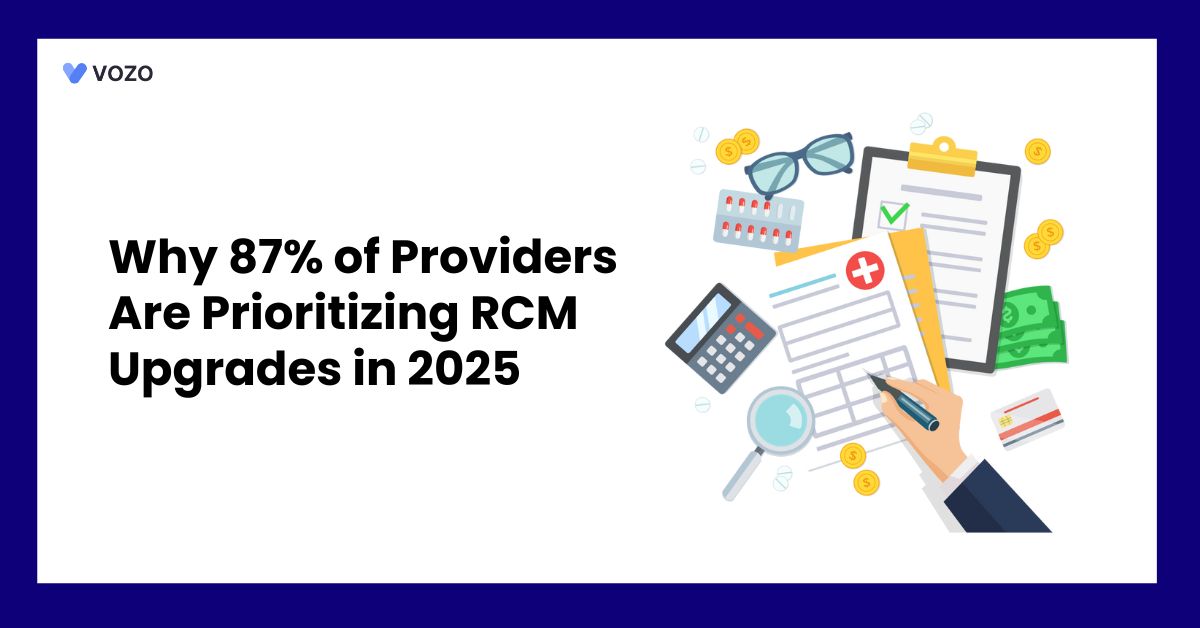Why 87% of Providers Are Prioritizing RCM Upgrades in 2025
Healthcare finance leaders enter 2025 acutely aware that every uncompensated claim threatens their bottom line. One recent analysis found 87% of hospital and health system executives report “intensified demands” for RCM system upgrades.
This surge reflects mounting financial pressures: rising claim denials, shrinking reimbursements, staffing shortages, and complex regulations are squeezing margins. Modern medical billing systems and patient eligibility verification tools offer a way out. These new platforms can close revenue gaps and free staff for higher-value work by automating claim submission, eligibility checks, and payment posting.
Even small yield improvements make a huge difference – for example, one Forrester‐commissioned study showed that a well‐optimized RCM platform could deliver 310% ROI over three years (with a $68.6M cost saving in six months and a 25-day drop in A/R). These data make clear why upgrading the revenue cycle is a top priority in 2025.
Key Pain Points in Today’s Healthcare RCM
Healthcare organizations face many revenue cycle roadblocks. Common pain points include:
1. High Claim Denials
Today’s average denial rates are well above target. Nationwide, about 15% of claims are initially denied by payers. In surveys, roughly 7 in 10 providers reported rising denials year-over-year. Each denial triggers time-consuming appeals – typically three rounds per claim – and back-and-forth with insurersfiercehealthcare.com.
This wastes staff time and cash: battling denials costs about $43.84 per claim on average (nearly $20 billion per year across the U.S.).
And even after appeal, a provider may only recover most (but not all) of the revenue: roughly half of denied claims are eventually paid, meaning a lot of money stays on the table.
Related: How to Utilize AI in Denial Management to Transform Practice Revenue
2. Staffing Shortages & Burnout
96% of revenue-cycle executives say a lack of qualified staff “significantly” hurts their revenue. Many groups struggle to hire and keep trained coders, billers, and eligibility specialists. High turnover (often 11–40% annually in RCM roles) means new, inexperienced hires make errors, which in turn drive up denials and rework. Over half of providers in one survey said shortages caused a spike in denials.
The result is slower collections and poorer cash flow: one MGMA poll found 56% of practices saw their days-in-A/R increase in 2022 due to staffing issues. Less revenue on time leads to thin working capital and fewer resources to invest in care.
3. Outdated Manual Processes
Many hospitals still rely on fragmented billing systems, fax-based authorizations, and manual data entry. These legacy processes are error-prone and inefficient.
- For example, Guidehouse found “higher-than-average denial rates indicate internal process breakdowns, documentation issues, and payer delay tactics,”.
- In practice, only a minority of leaders report denial rates in the ideal 0–2% range.
- Manual workflows also make it hard to keep up with frequent coding and policy changes.
Nearly half of providers collect ≤93% of all charges, meaning 7% of possible revenue is leaked, and the gap often stems from simple errors or missed follow-ups.
4. Regulatory & Payer Complexity
New rules are piling on RCM. For example, CMS will soon require insurers to return prior-authorization decisions in 3 days (urgent) or 7 days (standard).
The No Surprises Act and evolving billing codes add further layers. Outdated front-end tools force staff to spend hours on eligibility checks and surprise-billing compliance – an AMA survey found the average provider spends 12 hours per week on 43 prior authorizations. Without intelligent software, these requirements become crippling.
5. Patient Experience & Access
Modern patients expect digital convenience, but many providers lag. About 60% of patients say they want more online self-service options (scheduling, price estimates, bill-pay).
When front-office systems are slow or error-prone, patients get frustrated, bills are paid late (or not at all), and staff spend extra time handling inquiries. In short, clunky patient access tools undermine satisfaction and collections.
Together, these pain points sap revenue and morale. Providers routinely report rising days in A/R and cash shortages. For instance, Premier Inc. found that hospitals spent $25.7 billion in 2023 just contesting denied claims – a 23% jump from 2022.
The average day’s cash on hand fell to 196.8 days (a 10-year low) as a result. In other words, inefficiencies in the revenue cycle are threatening financial stability and the ability to reinvest in patient care.
Benefits of RCM Modernization
Given these challenges, modernizing RCM delivers powerful benefits:
1. Automation & Efficiency
New RCM platforms automate routine tasks. For example, they can instantly check insurance eligibility when patients register (avoiding billing mistakes), automatically validate codes against payer rules, and flag claim errors before submission.
- A 2024 Forrester study showed that a highly automated RCM system could slash administrative burdens: in one case, it achieved a 25‑day reduction in A/R and multimillion-dollar cost savings.
- Automation also frees skilled staff from repetitive work, allowing them to focus on complex issues like resolving the largest denials or improving clinical documentation.
- This productivity boost directly speeds up cash flow and reduces backlog.
2. Enhanced Compliance & Audit Trails
Modern solutions include up-to-date payer rules and built‑in regulatory checks. They can automatically apply the latest billing codes (ICD‑10, CPT, etc.), and keep audit logs for price transparency and data security rules.
In practice, this means far fewer “gotcha” denials from minor coding mistakes or missing prior-authorization notes. Industry experts agree that higher denial rates often stem from preventable errors and missing information – a modern RCM tool can catch these issues automatically.
By keeping compliance workflows consistent, upgrades reduce the risk of penalties and ensure clean claims (faster payment).
3. Improved Patient Financial Experience
Upgraded patient access tools (integrated with RCM) simplify the front end. Patients can get eligibility checks and cost estimates in real time, set up payment plans, and pay bills online.
Experian reports that when such tools are in place, patient frustration drops and on-time collections rise. Moreover, satisfied patients are more likely to follow through with care and payment. In an era where 60% of patients might switch providers for better digital access, offering seamless billing interactions becomes a competitive differentiator.
4. Cost Savings & Faster Revenue Capture
Consolidating multiple point solutions into an end-to-end platform cuts vendor and training costs. For example, moving from many separate systems to one integrated RCM suite eliminated redundancies for one health system, yielding billions in revenue recapture according to industry reports.
Less time spent on manual follow-up means more claims paid correctly on the first submission, and fewer dollars left uncollected. Studies show that even partial automation (like AI‑driven insurance discovery or robotic claims entry) produces high ROI. One analysis found that improving RCM efficiency brought millions in cost savings while increasing net revenue.
Related: How RCM Integrated EHR Solution Can Help to Improve Your Practice Revenue
5. Scalability and Agility
A modern RCM system scales easily. It can handle growth (new service lines, acquisitions, telehealth volumes) without needing proportional staff increases. Because it’s usually cloud‑based and modular, upgrades can be rolled out quickly when rules change or new payers come on board.
- In contrast, legacy systems often break or require laborious rewrites when something changes.
- Agility matters: as one healthcare analyst notes, scaling RCM operations gives organizations a competitive advantage by enabling faster decision-making and innovation.
6. Analytics & Revenue Insights
Advanced RCM platforms include dashboards and reports on key metrics (denial trends, payer performance, cash forecasts). These insights enable leaders to identify and fix trouble spots systematically.
For example, granular analytics can reveal that a particular payer denies knee-surgery claims at 20%, prompting renegotiation or process change. Over time, using data to drive RCM improvements builds a smoother, more predictable revenue cycle.
Strategic ROI and Competitive Edge
All these benefits translate into measurable ROI and long-term strength. A high-performing RCM can easily pay for itself in recovered revenue and reduced costs.
In the Forrester study cited above, the three-year ROI was 310% – meaning the investment returned more than three dollars for every dollar spent. Other industry data reinforce that trend: leaders now demand clear ROI before signing on to new billing or claims solutions.
A healthy RCM also protects future viability. With reimbursements under pressure, optimizing revenue capture has never been more critical. Reducing denials and accelerating payments effectively raises net reimbursement rates even without changing contract terms. Importantly, the capital freed by efficiency can be reallocated to patient care, technology, or staff, whereas stagnant cycles force cuts in these areas.
- Investing in RCM modernization is also a smart defensive move.
- As costs rise faster than revenue, margins are tight: Kaufman Hall found that collective operating margins are only modestly up in 2024 despite belt-tightening.
- Any waste or delay in the revenue cycle magnifies financial strain.
- By proactively fixing RCM bottlenecks now, a provider gains a competitive advantage – better cash flow, more predictable budgeting, and a positive reputation with payers and patients.
- One industry analysis highlights that leading health systems will use scaled RCM operations to “stand out from competitors” through innovation and rapid adaptation.
CFOs are taking note. Recent surveys show that 92% of RCM leaders plan major investments in AI and automation for the revenue cycle in 2025. They also emphasize the need for state-of-the-art systems to tackle issues like Medicare Advantage’s complex denials.
As one CFO put it, high MA denial rates force providers to absorb extra costs and uncertainty, so hospitals “must engage actively with plans, ensuring state-of-the-art information and processes” to close the reimbursement gap. In short, upgrading RCM is not just an IT project, but a finance strategy that CEO/CFO teams are prioritizing.
Vozo Revenue Management Cycle Service
At Vozo, we understand your struggle in navigating through all the revenue cycle processes, such as regulations, medical coding, and reimbursements.
That’s why we bring the best cutting-edge service to optimize your revenue cycle management from start to finish. Here’s how Vozo can help you transform your practice’s financial performance.
- Automated tools for error-free coding and faster reimbursements
- User-friendly billing to keep patients satisfied and payments flowing
- Robust data security and compliance protocols to protect your practice
- Detailed reporting and analytics for smarter business decisions
- Solutions that grow alongside your evolving needs
With Vozo RCM service, you can reduce the headaches associated with revenue cycle management and focus on what matters the most – quality patient healthcare delivery.
“Partner with Vozo RCM Service and unlock the full potential of your healthcare practice and maximize its revenue”.
About the author

With more than 4 years of experience in the dynamic healthcare technology landscape, Sid specializes in crafting compelling content on topics including EHR/EMR, patient portals, healthcare automation, remote patient monitoring, and health information exchange. His expertise lies in translating cutting-edge innovations and intricate topics into engaging narratives that resonate with diverse audiences.













